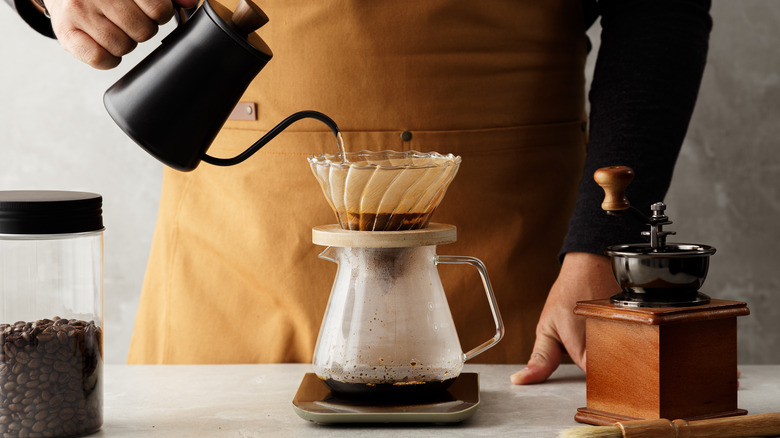Why It's Not Necessary To Time Your Coffee Blooms
You were probably already exhausted by all the different coffee-making terms and techniques before you ever heard about blooming, but we're here to tell you it's one part of the process you don't need to stress about.
Blooming coffee refers to the practice of soaking your grounds with a bit of warm water before the actual brewing process to help give them a fuller flavor. Instructions for blooming coffee usually say to pour the water and wait for 30 seconds before brewing, and this being coffee — which people have turned into an exact science of weight, time, and temperature — you would be forgiven for assuming that number is a precise one. But it isn't. It's not totally arbitrary, but there is no reason to time your blooms.
When you are blooming coffee, you are setting up the hot water to extract flavor from the beans more fully, and you are doing that by releasing carbon dioxide trapped in the beans that can inhibit extraction. That's why when you bloom coffee, it releases bubbles, and the grounds swell up in size. You can under bloom coffee, but this process has no upper time limit. Letting your coffee bloom for a minute, or two, or five won't burn it or lead to a watered-down tasting cup. Instead, you can rely on the visual clue of waiting for the bubbling to subside, which indicates that most of the CO2 has been released.
You can judge your coffee bloom on visuals
Carbon dioxide is produced in coffee beans as they roast and starts to leave as they sit and get ground. This compound brings both positive and negative things to your coffee. When the beans are whole, it helps protect them from going stale, but as CO2 leaves the beans, it also carries off some coffee taste, which is why ground beans lose their flavor so quickly. So you would think keeping the CO2 in the beans would be good, but it also interferes with the brewing process, first by adding a light sourness to the flavor and also by preventing water from fully coming into contact with the grounds. Essentially, all that gas you see bubbling off when you bloom creates air pockets that limit coffee extraction.
That's why using a little water to activate the CO2 release before you brew the coffee is so effective. You release some of the carbon dioxide that hurts brewing, but the water still limits the loss of flavor. Once the bubbling has stopped, it's a sign your coffee is evenly and fully saturated. Then once the brewing starts, you get good extraction. From that point on, timing matters even less; extended bloom times can even marginally improve the taste, though it's not typically worth waiting around for. Knowing what the visual signs of blooming mean obviates the need for a stopwatch when making coffee, and you'll get an even better cup.

